It's the end of the year and I and the future Mr$. Bonddad have plans. I will be back full time on Wednesday morning at the state of a new trading year.
So please -- have a good end of the year ---- and a safe end of the year. Some holidays bring out the nut jobs -- and this is one of them. So everybody have a good time but keep it cool.
BD
Friday, December 28, 2007
New York and NASDAQ New Highs/New Lows Index Is Ugly
These two charts are from stockcharts.com -- which is still one of the best technical analysis sites on the web.

On the NYSE, the index is slowly drifting lower.

On the NASDAQ, it's dropping far faster.
This tells us a very important point: the number of stocks hitting new lows is increasing faster than the number of stocks that are hitting new highs. This is not a healthy development for a bull market.

On the NYSE, the index is slowly drifting lower.

On the NASDAQ, it's dropping far faster.
This tells us a very important point: the number of stocks hitting new lows is increasing faster than the number of stocks that are hitting new highs. This is not a healthy development for a bull market.
Credit Crunch Alive and Well -- Very Well
This chart is from the Federal Reserve. Notice the amount of commercial paper has continued to drop with no abatement since August. I've drawn two horizontal lines to highlight the change.


The Bond Market Is Really Interesting Right Now
I have been watching the bond market with fascination lately because it is getting hit by several strong cross-currents. But first, let's review what moves the bond market. The following at not in any particular order, because the order can change depending on the overall investment environment.
-- Inflation expectations. Inflation eats into the fixed income stream of bonds. Higher inflation expectations should send the market lower and lower inflation expectations should send the bond market higher.
-- Flight to safety. Government bonds are considered ultra-safe investments, so in times of economic and geo-political stress they should rally.
-- Fed policy. If the Fed is lowering rates previously issued bonds are more valuable because they have a higher coupon. If the Fed is increasing rates the market should sell-off because new bonds have a higher and therefore more attractive coupon.
-- Overall interest rates on the bonds themselves. Remember -- a bonds price and yield move in opposite directions. As prices increase, yields decrease. But yields can only go so far. While they can technically drop to 0%, that is highly unlikely unless we're in serious trouble.
Notice that all of these factors are in play right now. First, commodity inflation is increasing, which should exert downward pressure on the markets. But the credit crunch and yesterday's news from Pakistan should make the flight to safety argument attractive. And then there is Fed policy, which is technically heading lower right now. But the Fed is seriously hemmed in by inflation. In other words -- all three of the primary events that move the bond market are in play right now which makes the day-to-day action really interesting.
Let's look at the charts to see what's going on.
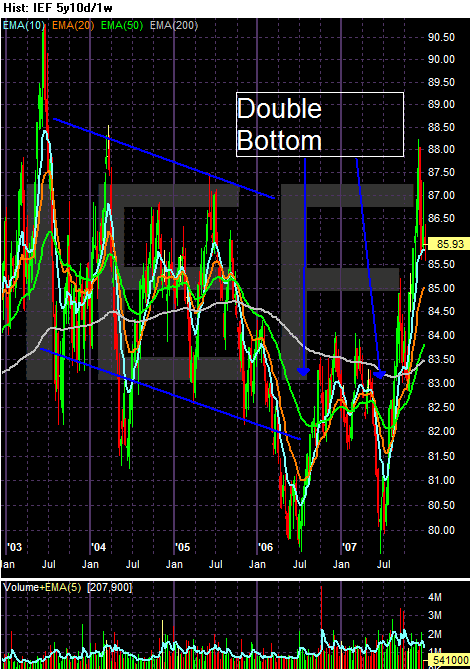
On the 5-year chart of the 7-10 year Treasury curve note the overall chart is one giant trading range between roughly 80 and 88. But there are several smaller trends within that range. The market was in a downward moving trend from 2003 - 2005. The market formed a double bottom in mid-2006 and mid-2007 and has rallied since the summer largely as a result of the problems in the credit market.

The 6 month chart clearly illustrates the rally. We have two primary moves up followed by very disciplined, profit-taking sell-offs.
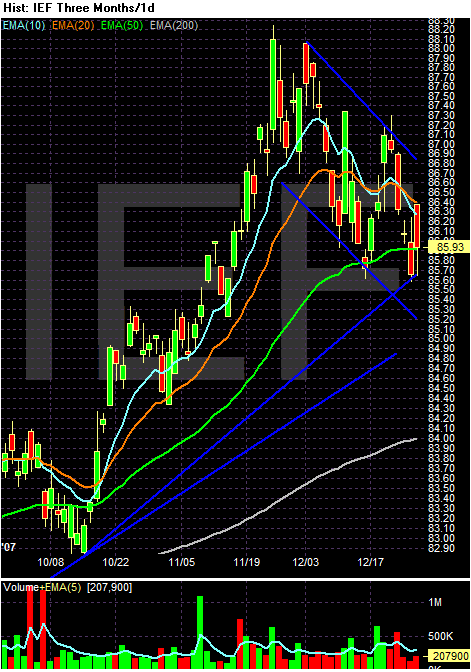
The three month-chart shows the latest sell-off. Notice the market is using the 50 day exponential moving average (EMA) as support and the shorter-term trends (10 and 20 EMS) are both heading lower. But the market is still about the 200 day EMA, implying we're still in a bull market.
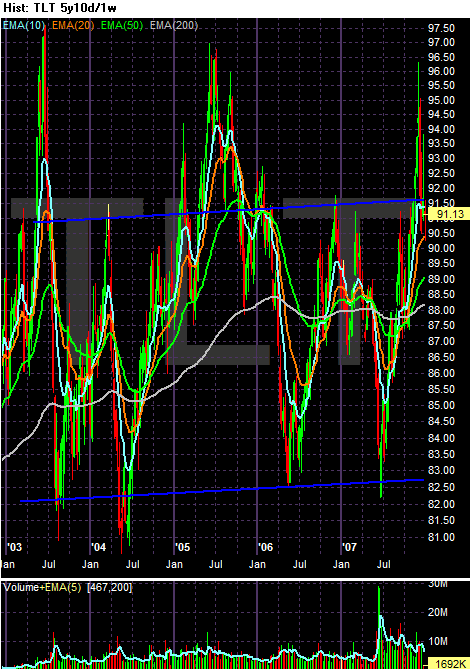
The five year 20+ Treasury market is clearly in one giant trading range between roughly 82.50 and 91.50. While the market has broken out of this range at both ends from time to time it has returned to this range at regular intervals.
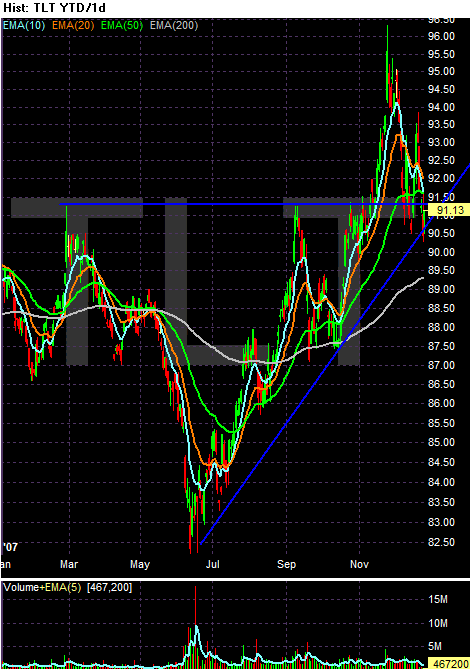
The 6 month chart shows the clear rally the market has been in since the credit crunch started. Like the IEFs, there are two primary moves upward followed by disciplined sell-offs.

The 3 month chart shows the TLTs are right at their 6-month trend right now. While the shorter (10 and 20) EMAs are moving lower, the primary trend line appears to be the dominate technical force right now.
So -- what comes next? Who knows at this point.
-- Inflation expectations. Inflation eats into the fixed income stream of bonds. Higher inflation expectations should send the market lower and lower inflation expectations should send the bond market higher.
-- Flight to safety. Government bonds are considered ultra-safe investments, so in times of economic and geo-political stress they should rally.
-- Fed policy. If the Fed is lowering rates previously issued bonds are more valuable because they have a higher coupon. If the Fed is increasing rates the market should sell-off because new bonds have a higher and therefore more attractive coupon.
-- Overall interest rates on the bonds themselves. Remember -- a bonds price and yield move in opposite directions. As prices increase, yields decrease. But yields can only go so far. While they can technically drop to 0%, that is highly unlikely unless we're in serious trouble.
Notice that all of these factors are in play right now. First, commodity inflation is increasing, which should exert downward pressure on the markets. But the credit crunch and yesterday's news from Pakistan should make the flight to safety argument attractive. And then there is Fed policy, which is technically heading lower right now. But the Fed is seriously hemmed in by inflation. In other words -- all three of the primary events that move the bond market are in play right now which makes the day-to-day action really interesting.
Let's look at the charts to see what's going on.

On the 5-year chart of the 7-10 year Treasury curve note the overall chart is one giant trading range between roughly 80 and 88. But there are several smaller trends within that range. The market was in a downward moving trend from 2003 - 2005. The market formed a double bottom in mid-2006 and mid-2007 and has rallied since the summer largely as a result of the problems in the credit market.

The 6 month chart clearly illustrates the rally. We have two primary moves up followed by very disciplined, profit-taking sell-offs.

The three month-chart shows the latest sell-off. Notice the market is using the 50 day exponential moving average (EMA) as support and the shorter-term trends (10 and 20 EMS) are both heading lower. But the market is still about the 200 day EMA, implying we're still in a bull market.

The five year 20+ Treasury market is clearly in one giant trading range between roughly 82.50 and 91.50. While the market has broken out of this range at both ends from time to time it has returned to this range at regular intervals.

The 6 month chart shows the clear rally the market has been in since the credit crunch started. Like the IEFs, there are two primary moves upward followed by disciplined sell-offs.

The 3 month chart shows the TLTs are right at their 6-month trend right now. While the shorter (10 and 20) EMAs are moving lower, the primary trend line appears to be the dominate technical force right now.
So -- what comes next? Who knows at this point.
Thursday, December 27, 2007
Today's Markets
Before we look at today's charts, let's look at the daily charts (yes, there's a reason for this). Today there was a big sell off. But.....
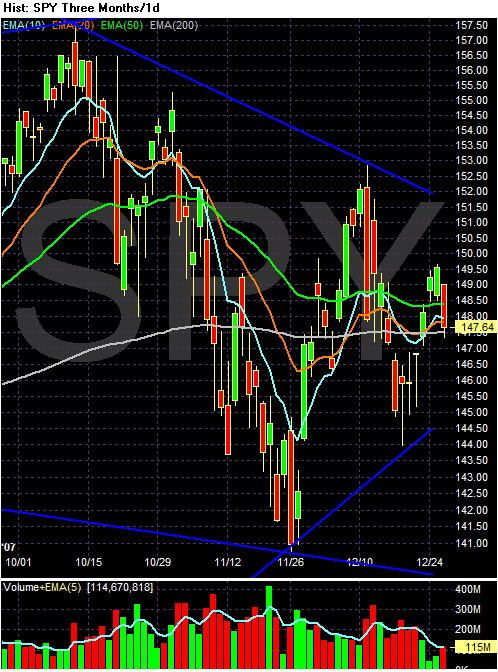
It didn't do a lot of technical damage to the SPYs. They retreated to the 200 day EMA. In addition, the EMAs (Exponential moving averages) are still bunched up, indicating the market is looking for direction in a big way.
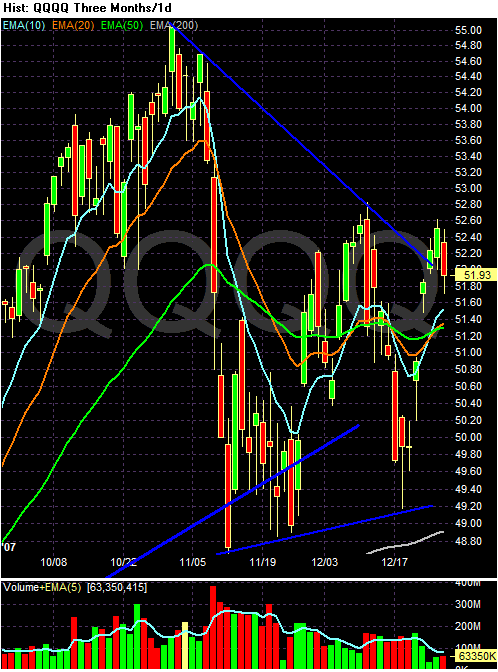
The QQQQs are still above the 10, 20 and 50 EMAs. Today's action looks more like a planned retreat than a huge sell-off.
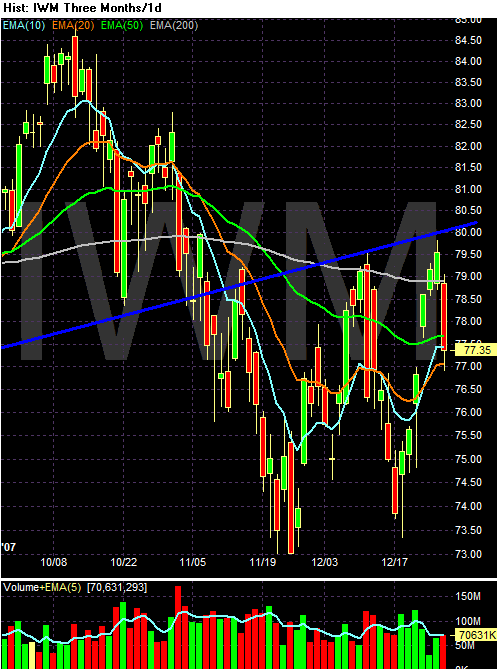
This is where a ton of damage could have been done. The IWMs retreated from their rally above the 200 day EMA. The good news is they retreated to an EMA which is currently providing technical support.
Moving to the 10-day 5 minutes charts...
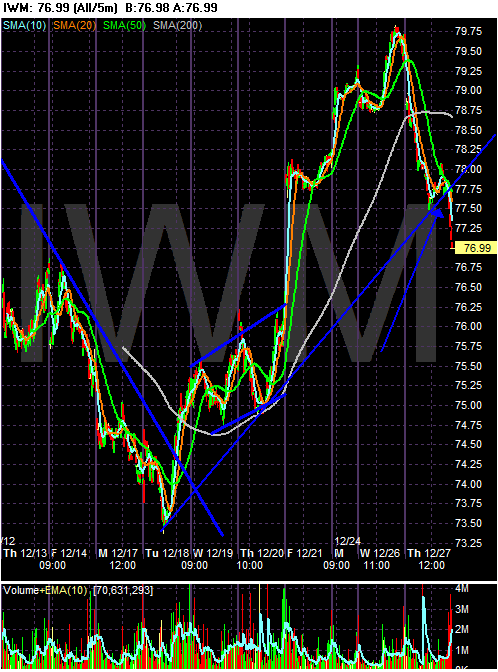
The IWMs broke technical support earlier today, which does not bode well for tomorrow's action.

The SPYs are still in an uptrend, although they broke technical support established 4 days ago.

The QQQQs are still firmly in an uptrend as well.
If you look closely at all the charts irrespective of support and resistance, they all look like simple rising indexes that had a healthy sell-off today. The real question is what happens tomorrow.

It didn't do a lot of technical damage to the SPYs. They retreated to the 200 day EMA. In addition, the EMAs (Exponential moving averages) are still bunched up, indicating the market is looking for direction in a big way.

The QQQQs are still above the 10, 20 and 50 EMAs. Today's action looks more like a planned retreat than a huge sell-off.

This is where a ton of damage could have been done. The IWMs retreated from their rally above the 200 day EMA. The good news is they retreated to an EMA which is currently providing technical support.
Moving to the 10-day 5 minutes charts...

The IWMs broke technical support earlier today, which does not bode well for tomorrow's action.

The SPYs are still in an uptrend, although they broke technical support established 4 days ago.

The QQQQs are still firmly in an uptrend as well.
If you look closely at all the charts irrespective of support and resistance, they all look like simple rising indexes that had a healthy sell-off today. The real question is what happens tomorrow.
More on Holiday Sales
From the NY Times:
From IBD:
As a result, retailers are offering "desperation discounts""
Bottom line -- things aren't looking that good for retailers right now.
By early December, the traditional start of the holiday buying rush, Coach, Target and Starbucks — arguably the reigning trendsetters among American retailers — warned that the number of consumers walking into their stores had begun to dip, or was likely to, as consumers restrained their spending.
Coach cautioned that the 20 percent growth rate for handbags over the last several years would most likely fall to 10 percent for the final months of this year — nothing to be ashamed of, but a significant setback. And Target, which is used to monthly sales increases of 4 percent or more for its stores, said results for December could fall 1 percent, a rarity for the chain.
A final sales tally from the season will not be available from most chains until next week. But an early projection from MasterCard Advisors, a unit of the credit card company, found that overall spending from Nov. 23 to Dec. 24, when adjusted for inflation, was essentially unchanged over last year, a weak performance.
From IBD:
A last-minute shopping frenzy probably wasn't enough to meet modest holiday sales forecasts, according to the latest retail estimates and discount giant Target. (TGT)
Same-store sales rose 2.8% in the week ended Dec. 22, the biggest weekly gain in two years, according to the International Council of Shopping Centers. But that didn't make up for poor showings in the weeks leading up to Christmas.
"Given the slow performance at the beginning of the month, it appears that the industry is on track for a sales gain that is slightly under our original expectation," ICSC Chief Economist Michael Niemira said in a statement.
As a result, retailers are offering "desperation discounts""
Dillard's Inc., Macy's Inc. and Home Depot Inc. slashed prices the day after Christmas as U.S. retailers attempted to avoid the worst holiday-shopping season since 2002.
Spending surges after the Thanksgiving holiday and last weekend weren't enough to boost holiday buying as consumers facing $3-a-gallon gasoline and declining home values limited gift purchases. The International Council of Shopping Centers lowered its November and December sales forecast yesterday.
``People should expect dramatic discounts, and in some cases, desperation discounts,'' Burt Flickinger, managing director at Strategic Resource Group, said yesterday in an interview on Bloomberg Radio.
Saks Inc. held a one-day, 70 percent-off sale yesterday on designer clothes. Dillard's is selling women's cashmere sweaters for 40 percent off. Polo Ralph Lauren Corp. was selling handbags at almost a 60 percent discount.
Bottom line -- things aren't looking that good for retailers right now.
Is Gold Moving Higher?
This is a chart I've been watching closely for the last few months. As inflation picks-up, I've wondered when gold would follow. Well, it looks like gold may be doing just that.
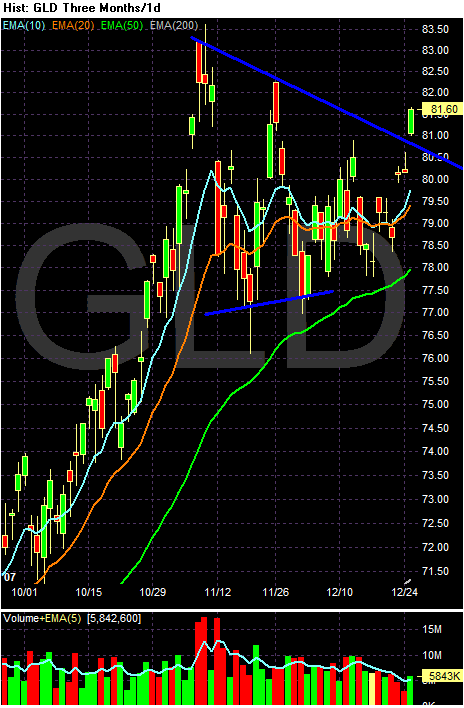
Notice that prices have been consolidating in a triangle pattern for the last two months. Yesterday we saw prices move through resistance on solid volume.
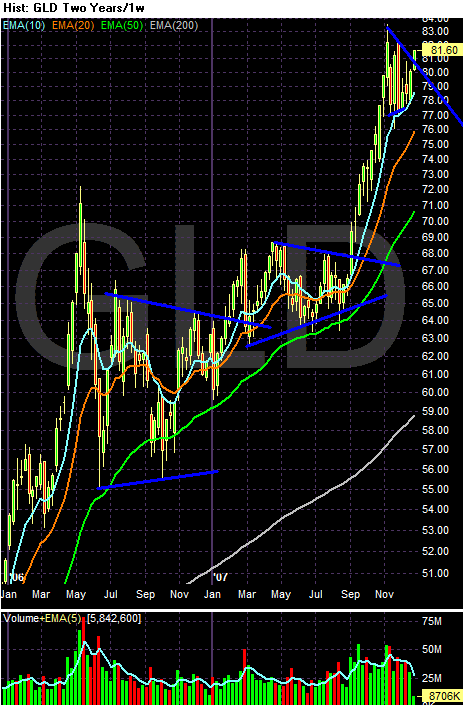
On the 2 year chart, notice that prices consolidated twice in 2007. The first consolidation occurred in March to September while the second occurred in October to November.
I use gold as a proxy for inflation expectations. In that vein, consider these long term charts.
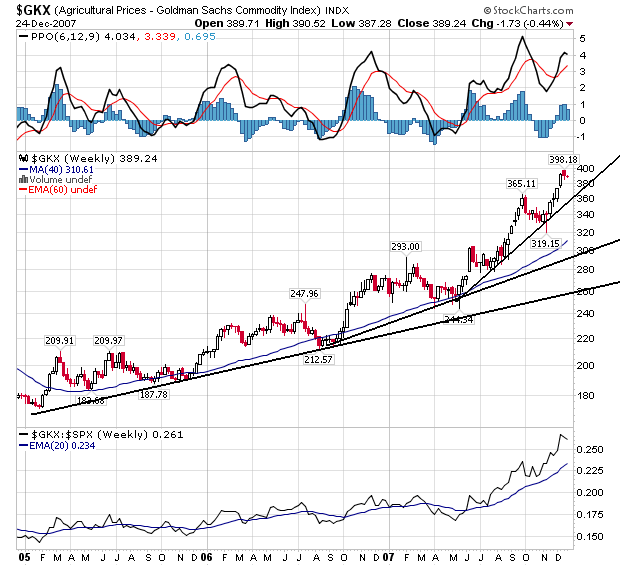
Agricultural prices are in a three year uptrend.
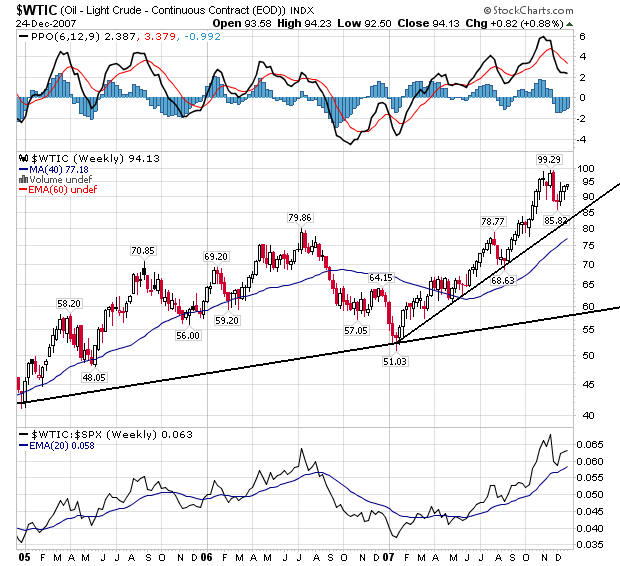
Oil prices are in a two year uptrend.

While the dollar has enjoyed a technical bounce over the last few weeks, it is still firmly in a downtrend.
The bottom line is prices are picking up across a variety of commodities. This is a demand driven situation -- 2 billion more people from India and China and living better. This was bound to happen sooner or later. Now we have to figure out how to deal with this development.

Notice that prices have been consolidating in a triangle pattern for the last two months. Yesterday we saw prices move through resistance on solid volume.

On the 2 year chart, notice that prices consolidated twice in 2007. The first consolidation occurred in March to September while the second occurred in October to November.
I use gold as a proxy for inflation expectations. In that vein, consider these long term charts.

Agricultural prices are in a three year uptrend.

Oil prices are in a two year uptrend.

While the dollar has enjoyed a technical bounce over the last few weeks, it is still firmly in a downtrend.
The bottom line is prices are picking up across a variety of commodities. This is a demand driven situation -- 2 billion more people from India and China and living better. This was bound to happen sooner or later. Now we have to figure out how to deal with this development.
Wednesday, December 26, 2007
Today's Markets
I'm going to start with the Russell 2000, because that's where some of the most interesting action is right now.

Sometime ago I wondered whether the IWMs had formed a double bottom. Well, they've had a nice end of the year rally and are currently at the point where they could break out from the highest point between the two bottoms. If this happens, they've got some room to run. In other words, this average could be setting up for a beginning of the year rally. Also notice the index has moved through all the moving averages. Also note the 10 and 20 day exponential moving averages (EMA) are pointing up. EMAs give more weight to more recent numbers, so they can be a better determinant of what traders are thinking now.

The SPYs are still in the middle of a triangle consolidation pattern. Note the EMAs are still bunched up big time, indicating the market is seriously lacking direction and could move in either direction right now.
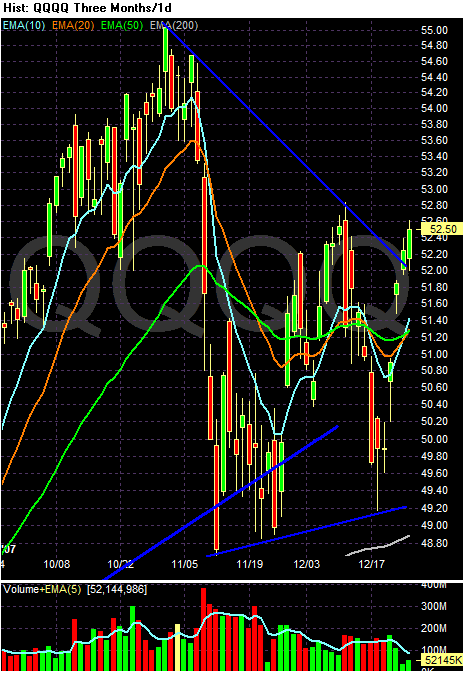
The QQQQs have broken through downside resistance. The EMAs while bunched are pointing higher. Also note this index is above the 200 day SMA. Remember -- because tech doesn't have any exposure to mortgages it's the golden child right now.
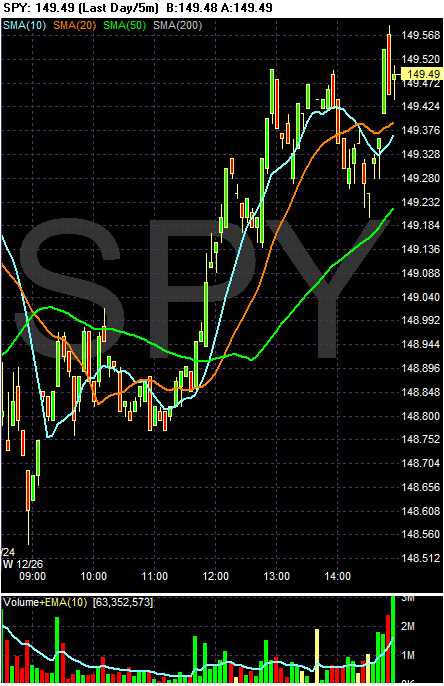
On today's chart, the SPYs opened lower, but got a big right before lunch. They closed on a high note with strong volume.
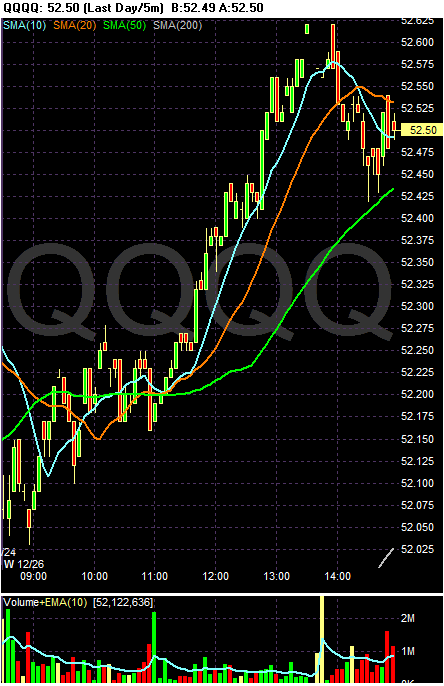
While the QQQQs had a nice rally today, they sold off at the end of trading. This is to be expected after a decent rally.
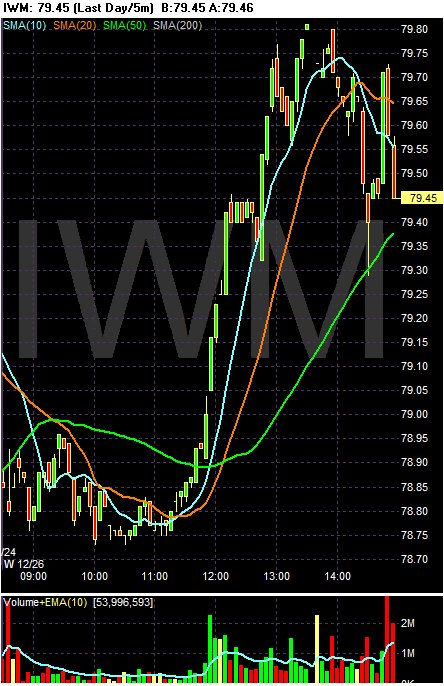
The IWMs had the strongest run today. For some reason, this average is really catching a strong bid right now. My guess is we're seeing a combination of bottom fishers coming into the market along with some beginning of the year positioning gong on right now.

Sometime ago I wondered whether the IWMs had formed a double bottom. Well, they've had a nice end of the year rally and are currently at the point where they could break out from the highest point between the two bottoms. If this happens, they've got some room to run. In other words, this average could be setting up for a beginning of the year rally. Also notice the index has moved through all the moving averages. Also note the 10 and 20 day exponential moving averages (EMA) are pointing up. EMAs give more weight to more recent numbers, so they can be a better determinant of what traders are thinking now.

The SPYs are still in the middle of a triangle consolidation pattern. Note the EMAs are still bunched up big time, indicating the market is seriously lacking direction and could move in either direction right now.

The QQQQs have broken through downside resistance. The EMAs while bunched are pointing higher. Also note this index is above the 200 day SMA. Remember -- because tech doesn't have any exposure to mortgages it's the golden child right now.

On today's chart, the SPYs opened lower, but got a big right before lunch. They closed on a high note with strong volume.

While the QQQQs had a nice rally today, they sold off at the end of trading. This is to be expected after a decent rally.

The IWMs had the strongest run today. For some reason, this average is really catching a strong bid right now. My guess is we're seeing a combination of bottom fishers coming into the market along with some beginning of the year positioning gong on right now.
An Overview of Recent Manufacturing Reports
Every month, several Federal Reserve Banks issue regional manufacturing reports. Rather than look at them one at a time, I like to look at them as a group to get a better overview of what is happening.
The Empire State survey wasn't good:
The Philadelphia Survey wasn't much better:
And the Richmond Fed showed a slowing as well
And the Chicago National Index was low as well:
The benefit of looking at all of these together is you can see if one report is out of place. However, an overview indicates there is a problem across regions. That's not a good sign going into the new year.
The Empire State survey wasn't good:
The Empire State Manufacturing Survey suggests a marked deceleration in manufacturing activity in December. The general business conditions index plummeted 17 points, to 10.3. The new orders and shipments indexes, while positive, also posted notable declines, and the unfilled orders index fell well below zero. The prices paid index eased slightly, and the prices received index held steady. The index for number of employees was modestly positive, while the average workweek index fell into negative territory for the first time since January. Future indexes were positive, but the degree to which activity is expected to expand over the next six months remained low compared with expectations earlier this year.
The Philadelphia Survey wasn't much better:
The survey’s broadest measure of manufacturing conditions, the diffusion index of current activity, fell notably, from 8.2 in November to -5.7 in December (see Chart). Fifty percent of the firms reported no change in activity from November, but the percentage of firms reporting decreases (27 percent) was greater than the percentage reporting increases (21 percent) for the first time since last December. However, other broad indicators suggest continued growth this month. Demand for manufactured goods, as represented by the survey’s new orders index, remained positive and increased seven points; the current shipments index increased 14 points. However, indexes for both unfilled orders and delivery times were negative.
And the Richmond Fed showed a slowing as well
Manufacturing activity in the central Atlantic region drifted lower in December, after stabilizing somewhat in November, according to the Richmond Fed’s latest survey. The index of overall activity was pushed into negative territory by weak readings for shipments and new orders. Other indicators were mixed. District contacts reported that the pace of hiring picked up, order backlogs changed little and delivery times edged slightly lower from a month ago. In addition, capacity utilization contracted at a quicker rate and manufacturers reported that growth in inventories expanded at a slightly faster pace.
And the Chicago National Index was low as well:
November economic growth below average
The Chicago Fed National Activity Index was −0.27 in November, up from −0.89 in October. Three of the four broad categories of indicators—employment, consumption and housing, and sales, orders, and inventories—made negative contributions to the index in November, while the production and income category made a slight positive contribution. (PDF,110KB)
The benefit of looking at all of these together is you can see if one report is out of place. However, an overview indicates there is a problem across regions. That's not a good sign going into the new year.
Personal Observations on the Shopping Season
What follows is anecdotal evidence.
I live in Houston, Texas where a big chopping center is called the Galleria. It's a giant mall with a ton of stores.. Here's a link for more information. It's pretty much centrally located in the Houston area, so it's pretty central to the area.
My dad was in town for the holidays and he stayed at a hotel in the area. My first thought was, "great. tons of traffic." But that wasn't the case. I went into town on Sunday morning and Sunday night. Getting through the area was no problem. In fact, it was less busy than rush hour.
On Monday -- Christmas Eve -- same thing. Traffic was incredibly manageable.
In previous years shopping seasons, this area of town has been a literal madhouse -- almost impossible to get through.
Again -- this is anecdotal information. For all I know, what appears to be fewer shoppers could have been buying up a storm. But the lack of traffic was pretty revealing.
I live in Houston, Texas where a big chopping center is called the Galleria. It's a giant mall with a ton of stores.. Here's a link for more information. It's pretty much centrally located in the Houston area, so it's pretty central to the area.
My dad was in town for the holidays and he stayed at a hotel in the area. My first thought was, "great. tons of traffic." But that wasn't the case. I went into town on Sunday morning and Sunday night. Getting through the area was no problem. In fact, it was less busy than rush hour.
On Monday -- Christmas Eve -- same thing. Traffic was incredibly manageable.
In previous years shopping seasons, this area of town has been a literal madhouse -- almost impossible to get through.
Again -- this is anecdotal information. For all I know, what appears to be fewer shoppers could have been buying up a storm. But the lack of traffic was pretty revealing.
Monday's Market Action
Monday was a holiday shortened day. That usually means lighter volume and the possibility of higher volatility. In addition, we're in the last two weeks of the year and there are holidays right in the middle of these last two weeks. So we'll have holiday shortened trading for the next 5-7 trading days. Trading won't resume at normal paces until a week from Monday (January 7).
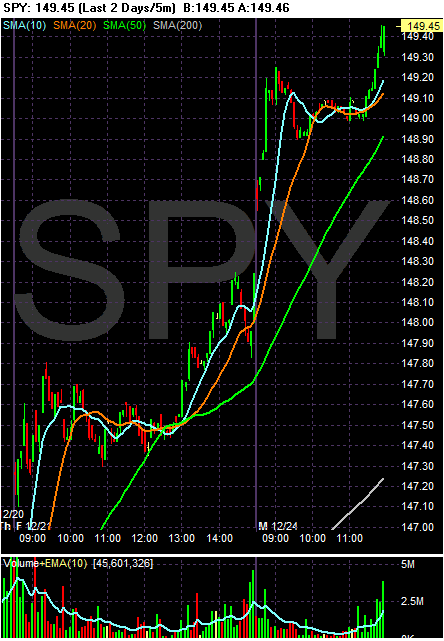
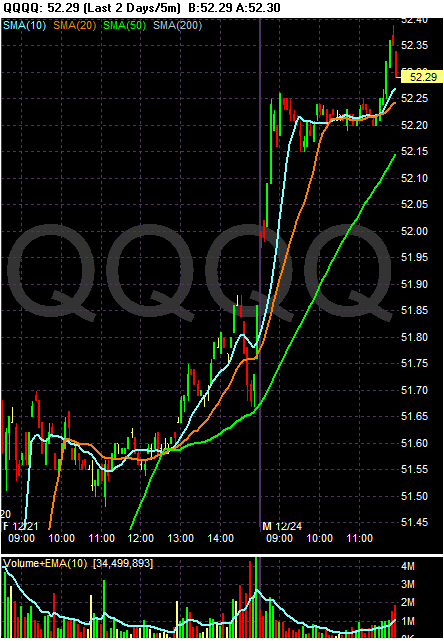

All the charts have the exact same patter. A strong pop at the opening, followed by consolidation until the last hour or so of trading. The only exception was the Russell 2000, which showed a bit more life mid-session.
Looking at the daily charts we see the following:

The SPYs are in the middle of a triangle consolidation pattern.
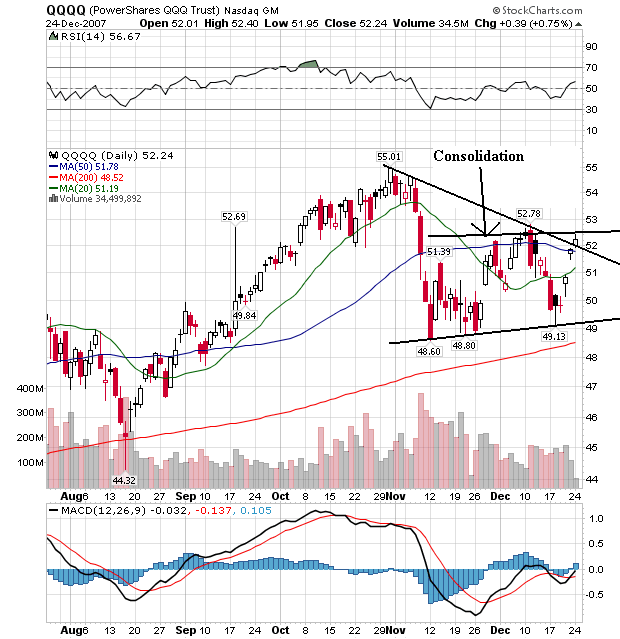
The QQQQs are also consolidating, but are doing so in a rectangle pattern. However, they have broken their short-term downtrend.
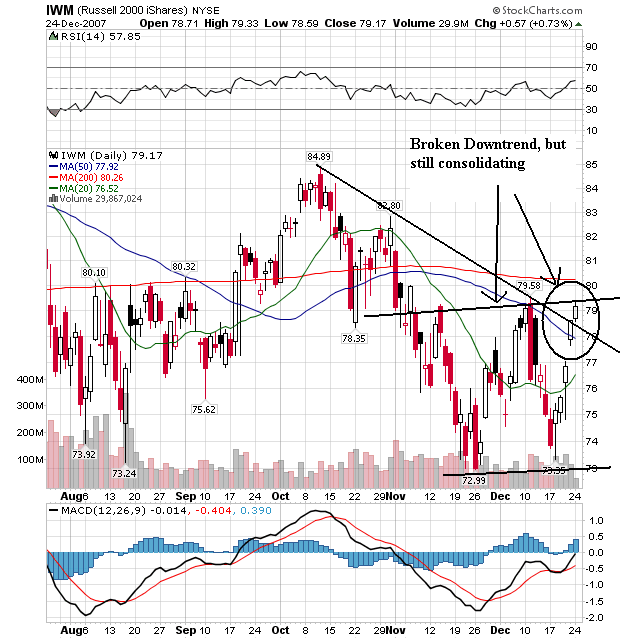
The Russell 200) (IWMs) have broken through their downtrend but are also consolidating.
I have no idea what to expect over the next few weeks. The moving averages are bunched up big time, indicating the market is also looking for direction.



All the charts have the exact same patter. A strong pop at the opening, followed by consolidation until the last hour or so of trading. The only exception was the Russell 2000, which showed a bit more life mid-session.
Looking at the daily charts we see the following:

The SPYs are in the middle of a triangle consolidation pattern.

The QQQQs are also consolidating, but are doing so in a rectangle pattern. However, they have broken their short-term downtrend.

The Russell 200) (IWMs) have broken through their downtrend but are also consolidating.
I have no idea what to expect over the next few weeks. The moving averages are bunched up big time, indicating the market is also looking for direction.
So -- How Was the Shopping Season?
Not that hot.
From the WSJ:
From Bloomberg:
It looks like sales increased, but not by as much as people wanted. In addition, there are serious questions about the impact of all the discounting on retailers bottom lines. While we'll have to wait until the next earnings season to find out, I don't think it's going to be good news.
From the WSJ:
Spurred by heavy discounting, U.S. shoppers spent furiously in the days just before Christmas. But holiday retail sales appeared to still fall short of industry expectations, setting the stage for bigger markdowns in the increasingly important post-Christmas period.
The 11th-hour rush helped strengthen a weak holiday season. From the day after Thanksgiving to midnight Monday, total retail sales, excluding automobiles, rose 3.6% over the previous year, according to MasterCard SpendingPulse, a unit of MasterCard Advisors. But factoring out spending on gasoline -- which soared thanks to a 27% average price increase since this time last year -- retail sales increased a lackluster 2.4%. Industry forecasts had predicted gains of 3.5% to as high as 4.5
"The surge at the beginning of the season and the surge at the end of the season definitely resulted in the modest growth that we saw," Michael McNamara, vice president of research and analysis for MasterCard Advisors, said in an interview yesterday. "If we didn't have those surges, it would have been a negative story."
From Bloomberg:
Last-minute purchases during the pre-Christmas weekend failed to salvage what may be the slowest holiday spending season in five years.
MasterCard Inc.'s consulting unit said yesterday that sales from Nov. 23 to Dec. 24 gained 3.6 percent. Spending in the week through Dec. 22 dropped 2.2 percent, the fourth week of declines, even after sales increased almost 20 percent over the weekend, Chicago-based ShopperTrak RCT Corp. said earlier this week.
Target Corp., the second-biggest U.S. discounter, said Dec. 24 that sales at stores open more than a year may decline in December after customer visits slowed in the weeks after Thanksgiving. Sales in November and December this year may rise 4 percent, the slowest growth since 2002, according to the National Retail Federation.
The late buying surge over the weekend is ``not going to overcome the negative forecasts,'' Frederick Crawford, managing director at Southfield, Michigan-based AlixPartners LLP, said in a Bloomberg Television interview. ``It's going to be a good start, a very weak midsection, and a strong finish. But those two barbells at the end are not going to be able to overcome these last three weeks, which have been very weak.''
It looks like sales increased, but not by as much as people wanted. In addition, there are serious questions about the impact of all the discounting on retailers bottom lines. While we'll have to wait until the next earnings season to find out, I don't think it's going to be good news.
Monday, December 24, 2007
Happy Holidays
Merry Christmas, Happy Holidays or whatever you celebrate.
I'll be back on Wednesday morning.
I'll be back on Wednesday morning.
Predictions For Oil Agree -- It's Going Higher
First -- I am usually not a big fan of economic predictions. The bottom line is there are far too many variables at play in the world economy to even think you can account for them all.
That being said, the fundamental supply and demand picture in the oil market is pretty easy to figure out. With India and China growing robustly you get an additional two billion people demanding oil. On the supply side, we haven't had a huge oil fiend find in a long time (I think decades).
So ...
Let's see what the charts have to say.

On the multi-year chart, we have a very strong uptrend in place. In addition, the sharpness of the angle is increasing. The latest rally started in late 2003 and has been running up ever since. Earlier this year we the market broker through last year's highs, indicating further upside potential for prices.
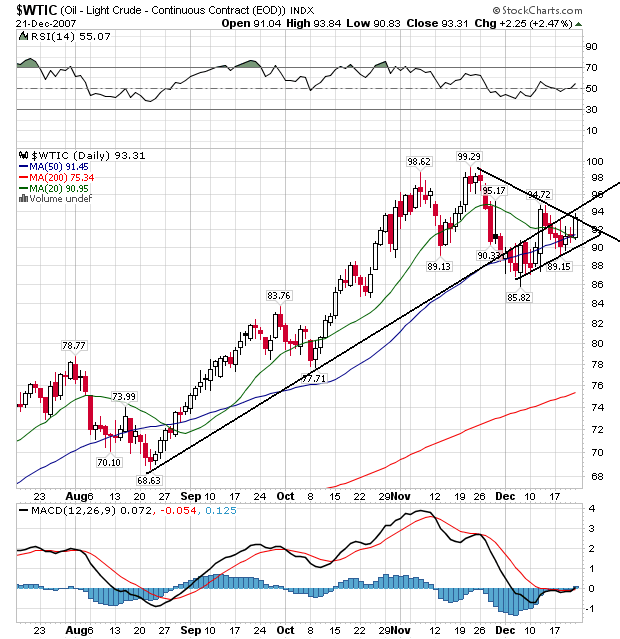
On the daily chart, notice that prices have broken through support from the rally started in late August. However, prices have not dropped in a big way. Instead they are consolidating in the upper 80s and lower 90s.
Short version: there's no reason to think this chart won't go higher barring the ever-present unforeseen event.
That being said, the fundamental supply and demand picture in the oil market is pretty easy to figure out. With India and China growing robustly you get an additional two billion people demanding oil. On the supply side, we haven't had a huge oil fiend find in a long time (I think decades).
So ...
Consumers are likely to pay a lot more at the pump, too. The Energy Department predicts that far higher average oil prices will force gasoline prices to even out at $3.11 next year, up 10% from the average price of $2.81 this year.
World crude prices have long tracked the thirst for oil in the U.S., which consumes about a quarter of the world's oil output. But recent months have shown how decoupled the oil market is becoming from the economic ups and downs of the world's largest energy consumer.
.....
"If I had to describe [2007] in one image, it would be dancing on thin ice," says Fatih Birol, chief economist at the International Energy Agency, which serves as an energy watchdog for rich countries. Global spare capacity is so thin, he says, "that any little thing now can influence price."
Let's see what the charts have to say.

On the multi-year chart, we have a very strong uptrend in place. In addition, the sharpness of the angle is increasing. The latest rally started in late 2003 and has been running up ever since. Earlier this year we the market broker through last year's highs, indicating further upside potential for prices.

On the daily chart, notice that prices have broken through support from the rally started in late August. However, prices have not dropped in a big way. Instead they are consolidating in the upper 80s and lower 90s.
Short version: there's no reason to think this chart won't go higher barring the ever-present unforeseen event.
But Will It Be a Good Christmas for Retailers?
From the WSJ:
At some point, cost-cutting eats into profits in a big way. I don't know if we are at that point with these numbers, but I think it's very possible we're going to see some nasty earnings surprises from some retailers in the Spring.
Some big stores, among them Macy's Inc. and Sears Holdings Corp.'s Kmart, stayed open around the clock to accommodate shoppers. And mega markdowns enticed many customers. Among them was Andy Gress, a teacher from Knoxville, Iowa, who braved a coming snowstorm to prowl the Jordan Creek Town Center west of Des Moines on Saturday. Having done much of his shopping weeks ago, he was back looking for stocking stuffers.
Merchants throughout the Iowa mall were advertising substantial discounts: "Everything 50% off," the sign in the New York & Co. window said. Across the hall, rival apparel retailer C.J. Banks, part of Christopher & Banks Corp., promised "Save up to 70% off."
"Sales were coming at the expense of profit margins," said A.T. Kearney's Mr. Mityas, referring to the spate of heavy promotions that characterized much of this holiday's marketing.
At some point, cost-cutting eats into profits in a big way. I don't know if we are at that point with these numbers, but I think it's very possible we're going to see some nasty earnings surprises from some retailers in the Spring.
Last Week's Markets
As we go into this holiday shortened week, let's start by looking at what the markets did last week.
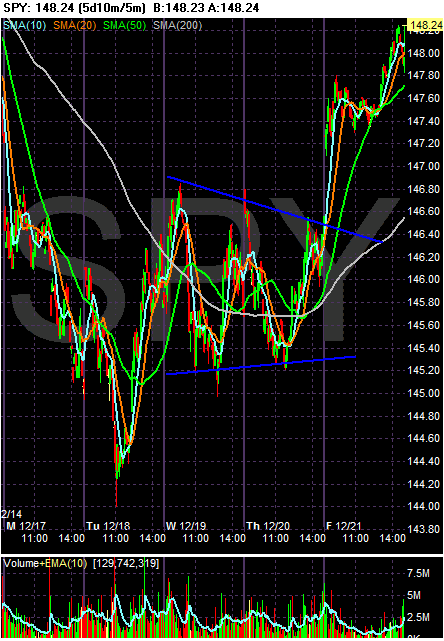
The SPYs dropped on Monday and Tuesday. They then consolidated in a triangle consolidation pattern on Wednesday and Thursday before breaking out with a big gap up on Friday.
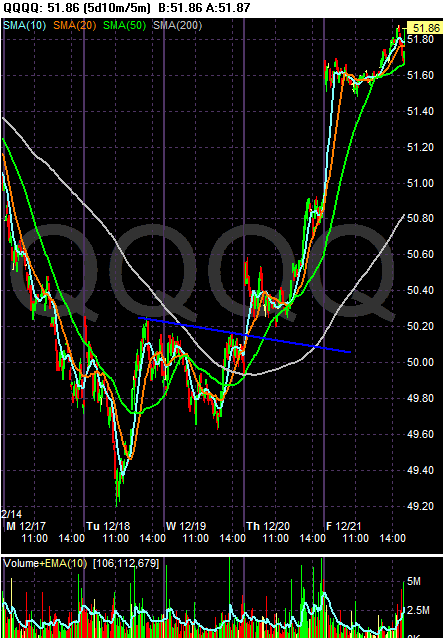
The QQQQs dropped on Monday and Tuesday, but broke out a day sooner than the SPYs on Thursday. Also notice the QQQQs gapped higher on both Tuesday and Wednesday.

This is by far the best chart of the week. Notice
-- the upward slanting consolidation pattern, and
-- the strong gap up on Friday.
I'm not expecting must to happen this week, largely because it is a holiday shortened week with far fewer people trading. That doesn't mean something won't happen; it's just far less likely.

The SPYs dropped on Monday and Tuesday. They then consolidated in a triangle consolidation pattern on Wednesday and Thursday before breaking out with a big gap up on Friday.

The QQQQs dropped on Monday and Tuesday, but broke out a day sooner than the SPYs on Thursday. Also notice the QQQQs gapped higher on both Tuesday and Wednesday.

This is by far the best chart of the week. Notice
-- the upward slanting consolidation pattern, and
-- the strong gap up on Friday.
I'm not expecting must to happen this week, largely because it is a holiday shortened week with far fewer people trading. That doesn't mean something won't happen; it's just far less likely.
Sunday, December 23, 2007
New Blog Hours
I'll be back in the morning.
Also, I want to announce new blog hours.
Monday morning (at the butt crack of dawn) to Friday afternoon at the market close.
Also, I want to announce new blog hours.
Monday morning (at the butt crack of dawn) to Friday afternoon at the market close.
Friday, December 21, 2007
Weekend Weimar and Beagle
The markets are closed and I have a lot of work to do this weekend. So --
don't think about the markets for today and tomorrow. I'll write an analysis of last week's markets on Sunday afternoon or early Sunday evening.
Until then, here are the kids, Kate and Sarge on the Weimar couch. Sometimes they even let me on the couch.

And here is the future Mr$. Bonddad's Beagle Scooby with some of here favorite toy's (and mine too).

don't think about the markets for today and tomorrow. I'll write an analysis of last week's markets on Sunday afternoon or early Sunday evening.
Until then, here are the kids, Kate and Sarge on the Weimar couch. Sometimes they even let me on the couch.

And here is the future Mr$. Bonddad's Beagle Scooby with some of here favorite toy's (and mine too).

A Closer Look At the Financial Sector
We've seen some interesting developments in the financial sector over the last few weeks. The primary development has been cash injections from foreign investors. This isn't the first time we've seen this happen. Citigroup was a beneficiary of this trend a bit ago. However, these cash injections haven't done a great deal for the financial sector.
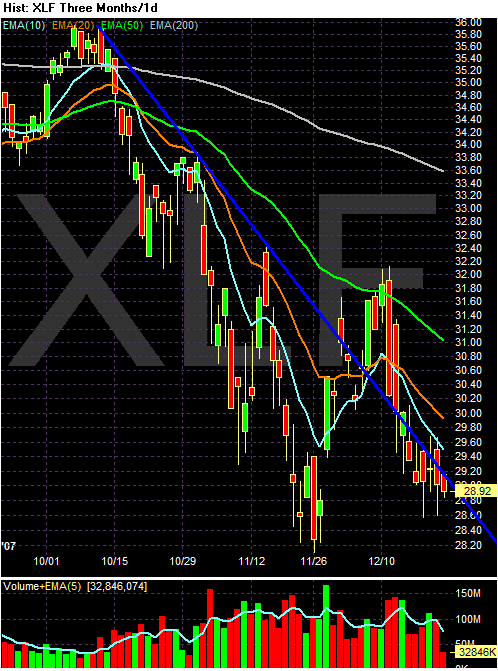
The XLF ETF is still clearly in a downtrend. Note that
-- prices are 16.5% below the 200 day SMA.
-- prices are below all the moving averages
-- all the movings averages are heading lower
-- prices are still centering around the long-term downtrend.
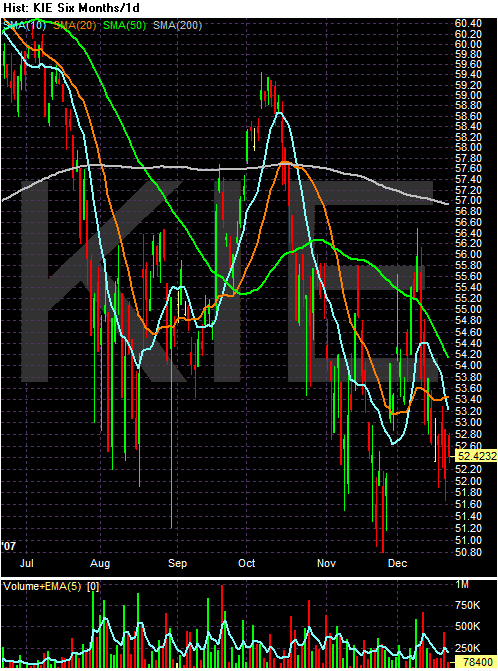
The insurance sector isn't in the best shape either. Notice
-- prices are 7.8% below the 200 day SMA
-- the shorter SMAs are below the longer SMAs
-- all the SMA are headed lower

Regional banks are in the same boat
-- prices are 13.66% below the 200 day SMA
-- prices are below the moving averages
-- all the moving averages are moving lower
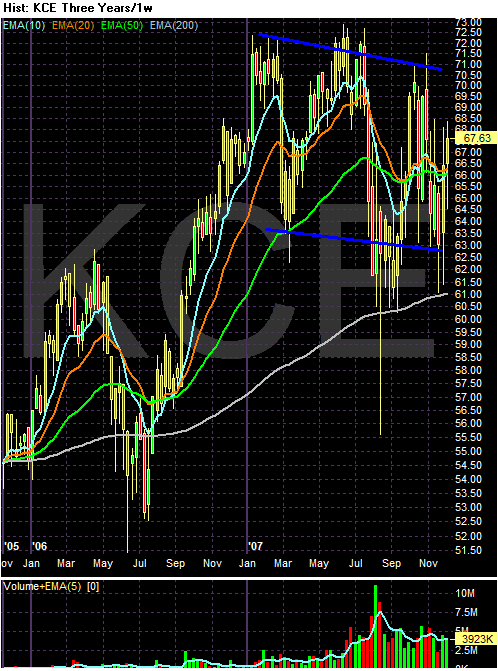
The capital markets long-term chart shows the industry in a downward slanting consolidation pattern
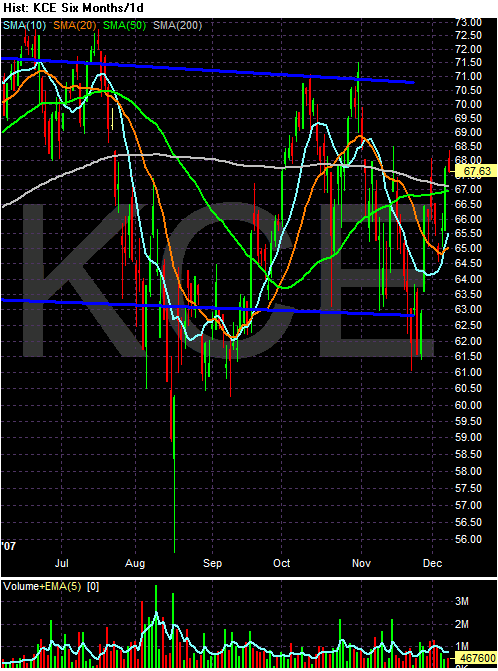
The six month chart shows
-- prices are hovering around the 200 day SMA
-- the shorter SMAs are below the longer SMAs, but
-- the SMAs are bunched up, meaning this segment of the market is looking for direction.
The only chart that looks good is the capital markets sector -- and that's an extremely relative term. That sector looks good because all the other sectors look pretty terrible. In short, this sector is still in terrible shape.

The XLF ETF is still clearly in a downtrend. Note that
-- prices are 16.5% below the 200 day SMA.
-- prices are below all the moving averages
-- all the movings averages are heading lower
-- prices are still centering around the long-term downtrend.

The insurance sector isn't in the best shape either. Notice
-- prices are 7.8% below the 200 day SMA
-- the shorter SMAs are below the longer SMAs
-- all the SMA are headed lower

Regional banks are in the same boat
-- prices are 13.66% below the 200 day SMA
-- prices are below the moving averages
-- all the moving averages are moving lower

The capital markets long-term chart shows the industry in a downward slanting consolidation pattern

The six month chart shows
-- prices are hovering around the 200 day SMA
-- the shorter SMAs are below the longer SMAs, but
-- the SMAs are bunched up, meaning this segment of the market is looking for direction.
The only chart that looks good is the capital markets sector -- and that's an extremely relative term. That sector looks good because all the other sectors look pretty terrible. In short, this sector is still in terrible shape.
Short Term Treasuries Still Rallying
Bonds are considered a safe haven investment -- which means when times get crazy, people flock to bonds. Here is a six month chart of the short-term Treasury market (1-3 years) which clearly illustrates this point.
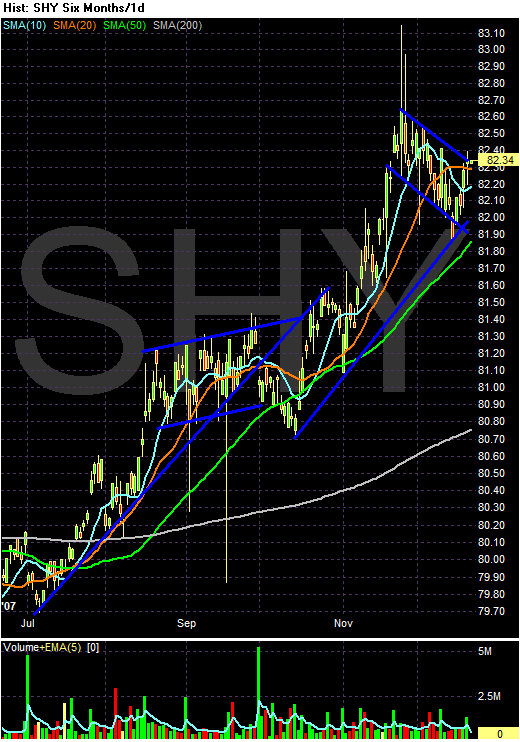
Over the last six months, this part of the Treasury curve has been in a clear bull market. The index rose from July through August, then consolidated for September. It sold off briefly at the beginning of September, but has rallied since.
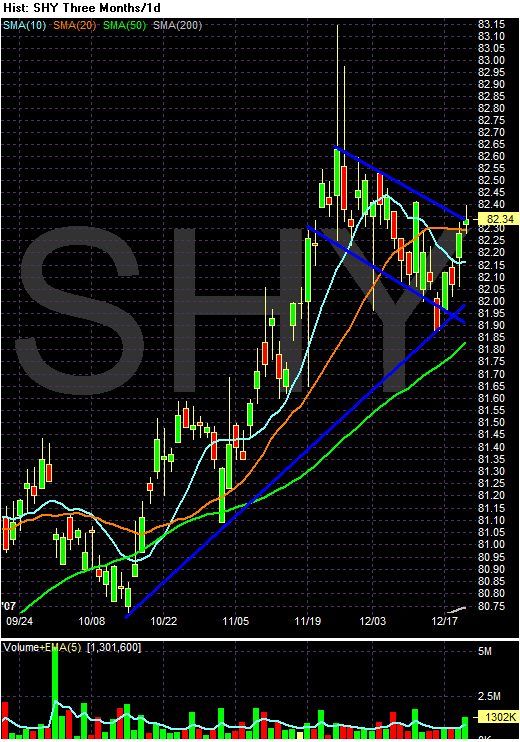
On the three month chart notice the index is clearly in a bull market pennant/flag pattern and is on the verge of breaking out of this for another upward run
Unlike stocks which theoretically have unlimited upside potential, bonds are constrained by interest rates. There is also the issue of inflation, which lowers the value of fixed income payments. With inflation increasing it seems bond prices would be selling off right now. But the trouble in the mortgage and commercial paper market is providing bullish "safe haven" stimulus. And the bad news in the mortgage market is continuing. This week alone, we've had bad news from Morgan Stanley, Bear Stearns and now news today that Merrill Lynch may have further writedowns in their mortgage portfolio. And while the latest liquidity injection by the ECD and the Fed help, they haven't solved the problem:
So far, safe haven investment status has trumped inflation. There is also a thought moving around the markets that inflation is being stoked by supply problems in the commodities markets, thereby limiting the inflation is increasing argument which should be bearish for bonds.
So, we basically have a sentiment tug-of-war going on in the bond market. The bulls are relying on safe haven status while the bears are pointing in increasing inflation pressures. Who will win? Who the hell knows at this point.

Over the last six months, this part of the Treasury curve has been in a clear bull market. The index rose from July through August, then consolidated for September. It sold off briefly at the beginning of September, but has rallied since.

On the three month chart notice the index is clearly in a bull market pennant/flag pattern and is on the verge of breaking out of this for another upward run
Unlike stocks which theoretically have unlimited upside potential, bonds are constrained by interest rates. There is also the issue of inflation, which lowers the value of fixed income payments. With inflation increasing it seems bond prices would be selling off right now. But the trouble in the mortgage and commercial paper market is providing bullish "safe haven" stimulus. And the bad news in the mortgage market is continuing. This week alone, we've had bad news from Morgan Stanley, Bear Stearns and now news today that Merrill Lynch may have further writedowns in their mortgage portfolio. And while the latest liquidity injection by the ECD and the Fed help, they haven't solved the problem:
The latest massive maneuvers by the Federal Reserve and European Central Bank have had the desired calming effect on money markets. But as those central banks acknowledge, the moves haven't eliminated the threat from a cascade of bad news from financial firms, worries about more bad news to come and the likely impact of falling U.S. housing prices.
The most visible indicator of persistent bank reluctance to lend to each other -- plus the reluctance of money-market mutual funds to lend to banks for more than a few days -- has been that banks are paying unusually high rates for short-term loans, compared with the target the Fed and ECB set for overnight loans.
The central banks have "alleviated a lot of the train-wreck fears about year-end," says Lou Crandall, chief economist at Wrightson ICAP, a New York bond-research firm. While the central banks' actions are temporary -- extending only through January -- "it buys us more time, which is the only thing that's going to resolve this."
So far, safe haven investment status has trumped inflation. There is also a thought moving around the markets that inflation is being stoked by supply problems in the commodities markets, thereby limiting the inflation is increasing argument which should be bearish for bonds.
So, we basically have a sentiment tug-of-war going on in the bond market. The bulls are relying on safe haven status while the bears are pointing in increasing inflation pressures. Who will win? Who the hell knows at this point.
Thursday, December 20, 2007
Today's Markets
Finally! The charts are starting to make sense.
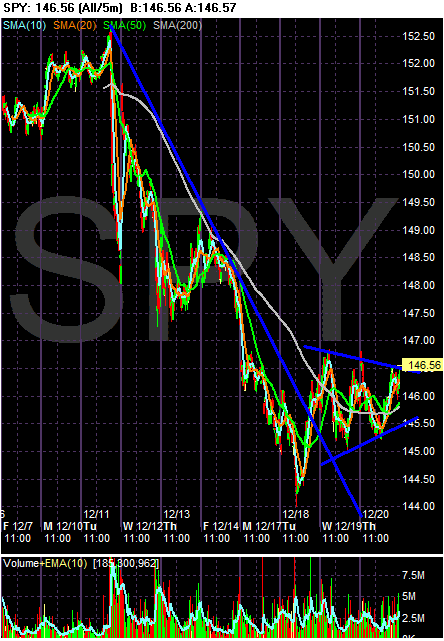
On the 10 day, 5 minute SPY chart, note the market has been selling off for the five days after the Fed's policy action (or inaction as the market saw it). However, the market bottomed two days ago and has since been forming a triangle consolidation pattern.
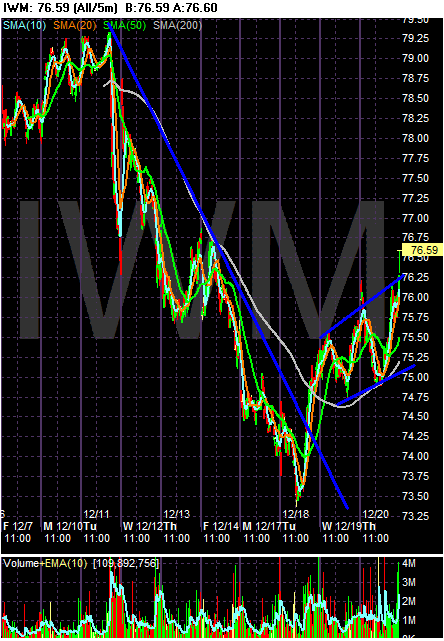
On the IWMs, notice the same situation, except the market formed an upward sloping broadening pattern. However,
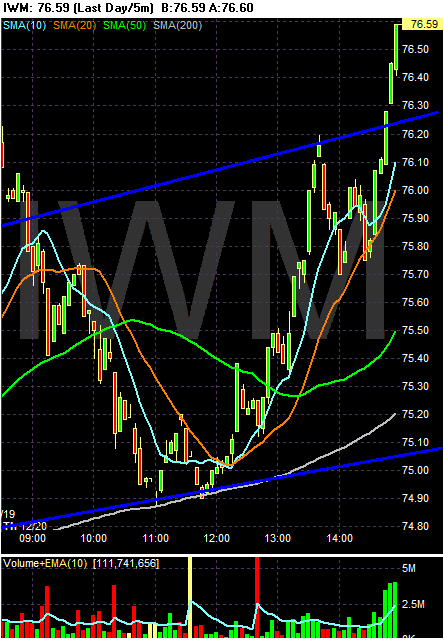
Notice the IWMs broke out of the range right at the end of trading on heavy volume. That's a bullish sign.

With the QQQQs, notice we have the same sell-off, but a much stronger upward move after the market bottomed.

Also notice that prices are formed a triangle consolidation pattern with some heavy buying in the last two hours of trading.

On the 10 day, 5 minute SPY chart, note the market has been selling off for the five days after the Fed's policy action (or inaction as the market saw it). However, the market bottomed two days ago and has since been forming a triangle consolidation pattern.

On the IWMs, notice the same situation, except the market formed an upward sloping broadening pattern. However,

Notice the IWMs broke out of the range right at the end of trading on heavy volume. That's a bullish sign.

With the QQQQs, notice we have the same sell-off, but a much stronger upward move after the market bottomed.

Also notice that prices are formed a triangle consolidation pattern with some heavy buying in the last two hours of trading.
Subscribe to:
Comments (Atom)